Military Police of Rio de Janeiro State
| State Police of Rio de Janeiro Polícia Militar do Estado do Rio de Janeiro | |
|---|---|
| Abbreviation | PMERJ |
|
Blazon of the Military Police of Rio de Janeiro State | |
|
Old badge of the Military Police of Rio de Janeiro State | |
| Motto |
To serve and protect Servir e proteger |
| Agency overview | |
| Formed | May 13, 1809 |
| Employees | 52,000 (2014) |
| Legal personality | Governmental: Government agency |
| Jurisdictional structure | |
| Operations jurisdiction* | State of Rio de Janeiro, Brazil |
 | |
| Map of police jurisdiction. | |
| Size | 43.696,054 km² (16,871.1 sp mi) |
| Population | 16,010,429 (2009) |
| General nature | |
| Operational structure | |
| Headquarters | City of Rio de Janeiro |
| Website | |
| Official website | |
| Footnotes | |
| * Divisional agency: Division of the country, over which the agency has usual operational jurisdiction. | |
The Military Police of Rio de Janeiro State (Portuguese: Polícia Militar do Estado do Rio de Janeiro) (PMERJ) like other military polices in Brazil is a reserve and ancillary force of the Brazilian Army, and part of the System of Public Security and Brazilian Social Protection.[1] Its members are called "State Military" person.[2]
The primary mission of PMERJ is ostensibly preventive policing for the maintenance of public order in the State of Rio de Janeiro.
Under the United Nations, in cooperation with the Brazilian Army, the Military Police of Rio de Janeiro State has served in Angola, Mozambique, East-Timor, Sudan, and Haiti.
History
The first militarized police in Portugal (when Brazil was still a colony) was the Royal Police Guard of Lisbon (Portuguese: Guarda Real de Polícia de Lisboa), established in 1801,[3] which followed the model of the National Gendarmerie (French: Gendarmerie Nationale) of France, created in 1791.
When the Portuguese Royal Family was transferred to Brazil, the Royal Police Guard of Lisbon remained in Portugal, and another equivalent guard was created in Rio de Janeiro under the name of Military Division of the Royal Police Guard of Rio de Janeiro, in 1809.[4]
With the abdication of Emperor Pedro I in 1831, the Regency held reformulations on the Brazilian Armed Forces. The Royal Guard Police of Rio de Janeiro became extinct,[5] and was replaced by the Municipal Guard Corps of Volunteers,[6] a type of security force similar to the National Guard. The same law allowed each Province to establish its own Guard of Volunteers.
In 1834, Pedro I died in Portugal and this reduced the fear in Brazil of a reunification of the kingdoms. The Guard of Volunteers were then transformed into Province Police Corps, with professional troops.[7] The Police Corps were created with the same structure as Brazilian Army, and to serve as reserve troops when necessary, under provinces presidents' control. In 1835, the president of Rio de Janeiro province created the "Rio de Janeiro Province Police Corp" (Guarda Policial da Província do Rio de Janeiro).
With the Proclamation of the Republic, Brazil adopted a constitution based on the United States, where the states have a large autonomy. The Corps of Police were renamed Public Forces (Força Pública) and began to be administered by the states governors and became smaller regional armies, with infantry, cavalry, artillery, and later, even with air forces. This dangerous situation to the national security remained until the rise of Getúlio Vargas dictatorial government in 1930s, when he abolished states autonomy, after Constitutionalist Revolution and Estado Novo coup, and the Brazilian army began its control over states military polices and military firefighters corps - including the then Federal District Military Police, which served the city during its days as the national capital city until 1960, alongside the Military Police of Rio de Janeiro State, which was separated from the city, until both organizations were merged in 1975.
Attributions and mission
The constitutional attributions of the Military Police of Rio de Janeiro State (PMERJ) are provided for in § 5 of Article 144 of the Constitution, "the military police responsible for the ostensive policing and the maintenance of public order".
In addition:
- In the fight against organized crime, through operations to catch criminals or seizure of weapons, drugs or contraband.
- Providing direct services to the population, helping to transport patients, the orientation of people in difficulty, the intervention of domestic disputes, the routing of the poor to the agencies responsible for sanitation problems, housing
- In specialized policing in tourist areas, stadiums, major events and festivals.
- The supervision and control of the vehicle fleet in integrated actions with other public agencies.
- The preservation of flora, fauna and the environment through specialized battalion.
- In the security service forums of Justice in municipalities throughout the state.
- In support of court officers in repossession cases and other court orders with risk.
- The security of the executive authorities, the legislature and the judiciary.
- Security of witnesses and people under threat.
- In support of public, state and municipal agencies in activities such actions with the population of street and dealing with children and adolescents at social risk.
Organization
The PMERJ is operationally organized into Intermediary Commands or Policing Area Command (Portuguese: Comandos Intermediários/Comandos de Policiamento de Área), Military Police Battalions, companies, and platoons; and administratively, in departments. Independent companies police sizable towns.
The battalions are based in major urban centers, and their companies and platoons are distributed according to population density in cities.
The Military Police of Rio de Janeiro is present in all cities of the State.
Special Police Operations Battalion
The idea of a group of police officers who were specifically trained to work in extreme risk situations arose after the tragic outcome of the hostage incident in the Criminal Evaristo de Moraes Institute in 1974. At the time the director of the prison, the police Major Darcy Bittencourt, who was held hostage by criminals who tried to escape, he was killed along with some arrested after the intervention of the police force. It was established on January 19, 1978, the Bulletin of the Military Police No. 014 on the same date as Center of Special Operations Company, through an elaborate project and presented by Captain PM Paulo César de Amendola de Souza, who witnessed the crisis, then the general commander of PMERJ, Col. Mário José Sotero de Menezes. Running in CFAP facilities of volunteers and operationally subordinate to the Chief of Staff of PMERJ. The NuCOE worked at a camp on the premises of Squares Training Centre (GFC) in Sulacap in northern Rio. There were 12 tents for about 30 policemen. On March 1, 1991, there was the creation of the Special Police Operations Battalion (BOPE).[8]
In 2001, the BOPE adopted armored vehicles baptized as caveirões to protect PMs in raids in slums. Thus, the battalion was heavily criticized by human rights groups for having printed the insignia of skull pierced by a dagger.
The BOPE is considered today one of the leading police forces to combat urban guerrilla in the world, that due to its wide experience gained in over 30 years of repression of drug traffickers and armed gangs in the favelas of Rio de Janeiro.[8][9][10][11]
Pacifying Police Unit
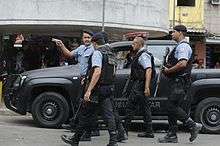
Pacifying Police Unit is a State Department project in Rio de Janeiro Security that seeks to establish community police in slums, mostly in the state capital, in order to dismantle gangs that previously controlled these territories as true parallel states. Before the project, opened in 2008, only the Tavares Bastos favela, among the more than 500 existing in the city, had no organized crime and drug trafficking.
Because the favelas with Pacifying Police Units had formerly been controlled by armed drug traffickers for more than twenty-five years, the fear of retribution, which was a mainstay of the "law of the traffickers" is slow to die. For instance, in April 2012 when a drug trafficker who had formerly controlled the favela of Mangueira was shot and killed during a police operation in Jacarezinho (before the area had received its own Pacifying Police Unit), others from the same criminal faction ordered businesses to close their doors early in Mangueira — which they did. This despite the fact that Mangueira has a permanent pacification police force as part of its own Pacifying Police Unit. A similar occurrence of businesses closing their doors early in Mangueira because the traffickers ordered it occurred in February 2013.
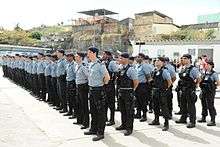
In May 2012, Beltrame acknowledged that armed criminals had migrated from parts of Rio that have a large police presence due to pacification, to areas with less police and no Pacifying Police Units, such as Niterói, which is nearby, across the bay. Beltrame has stated however that he believes based on analysis of crime data that only gang leaders higher in the hierarchy could reestablish in other favela communities (without Pacifying Police Units); and that lower level traffickers have a much harder time integrating into other geographic areas.
While the favela areas under pacification have seen improvements, there has been an increase in the concentration of criminals in other parts of Rio de Janeiro that don't have the direct benefits of permanent pacification police forces actively patrolling these neighborhoods. Among these areas are those of the Baixada Fluminense, Niterói, and certain neighborhoods in the North Zone.
It was obvious early on that criminals were fleeing particular favelas before BOPE entered to establish a groundwork for a permanent police presence. Previously, when police had attempted to encircle a favela by surprise in order to arrest and kill traffickers, large-scale shootouts would ensue, and innocent favela residents were caught in the crossfire.
While more high-profile gang leaders (also referred to in Rio's media as "traffickers") have been forced to leave favelas now administered by UPP police forces, their familial connections remain. Also, gang members from other favelas who are of the same faction as residents under Pacifying Police Units, still coordinate and visit each other. Exemplifying this point, one of Rio's newspapers reported on July 9, 2012 that groups of criminals fired upon police in different locations within the Complexo do Alemão on the same day that military forces completed their final withdrawal from the area.
There is a well known history of police abuse and corruption in Rio de Janeiro, and for years this only added fuel to the war between drug traffickers controlling Rio's favelas and the police.
In recent years there have been concerted efforts under Secretary Beltrame to root out corrupt police; and this is the very reason that the community policing of the favelas under the Pacifying Police Unit program are staffed by new recruits coming straight from the Pacifying Police Unit police academy — such as the 750 officers who will be policing the large Rocinha favela beginning in August 2012.
Beltrame has stated that the main purpose of the Pacifying Police Units is more toward stopping armed men from ruling the streets than to put an end to drug trafficking. A 2010 report by the World Organization Against Torture did note the drop in the homicide rate within Rio de Janeiro's favelas.[12]
Campaigns against crime and shootings
- Complexo do Alemão massacre
- June 27, 2007, was the result of an ongoing conflict between drug dealers and the police in the borough of the same name in Rio de Janeiro, which consisted of a group of large favelas in the northern region of the city, when a large Military Police and Civil Police of Rio de Janeiro State operation killed 19 people and injured several others.
- Helicopter shot down in gun battle
- October 18, 2009, two policemen were killed after gang members shot down their helicopter during a battle with police in Rio de Janeiro, Brazil. Twelve people were killed on the ground, including two civilians. Ten of those are said to have been gang members.
- 2010 Rio de Janeiro Security Crisis
- In November 2010, there was a major security crisis in the Brazilian city of Rio de Janeiro and some of its neighboring cities. The city's criminal drug trafficking factions initiated a series of attacks in response to the government placing permanent police forces into Rio's slums.
- Rio de Janeiro school shooting
- April 7, 2011, 12 children aged between 12 and 14 were killed and 12 others seriously wounded after an armed man entered Tasso da Silveira Municipal School, an elementary school in Realengo on the western fringe of Rio de Janeiro. Two policemen who were patrolling the area were alerted, military policeman Third Sergeant Márcio Alexandre Alves shot the gunman in the leg and in the stomach; he fell down a staircase and then committed suicide by shooting himself in the head.
Commands and Battalions of Military Police
These are the Policing Area Commands and their respective battalions. Cities and neighborhoods indicate the location of their headquarters.
_01.jpg)
- 1st Policing Area Command – city of Rio de Janeiro
- 1st Battalion – Estácio
- 2nd Battalion – Botafogo
- 3rd Battalion – Méier
- 4th Battalion – São Cristovão
- 5th Battalion – Saúde
- 6th Battalion – Tijuca
- 13th Battalion – Downtown
- 16th Battalion – Olaria
- 17th Battalion – Ilha do Governador
- 19th Battalion – Copacabana
- 22nd Battalion – Maré
- 23rd Battalion – Leblon
- 1st Independent Company (Governor's Palace Guard) – Laranjeiras
- 2nd Policing Area Command – city of Rio de Janeiro
- 9th Battalion – Rocha Miranda
- 14th Battalion – Bangu
- 18th Battalion – Jacarepaguá
- 27th Battalion – Santa Cruz
- 31st Battalion – Barra da Tijuca
- 40th Battalion – Campo Grande
- 41st Battalion – Irajá
- 3rd Policing Area Command – city of Mesquita
- 15th Battalion – city of Duque de Caxias
- 20th Battalion – city of Mesquita
- 21st Battalion – city of São João de Meriti
- 24th Battalion – city of Queimados
- 34th Battalion – city of Magé
- 39th Battalion – city of Belford Roxo
- 4th Policing Area Command – city of Niterói
- 7th Battalion – city of São Gonçalo
- 12th Battalion – city of Niterói
- 25th Battalion – city of Cabo Frio
- 35th Battalion – city of Itaboraí
- 5th Policing Area Command – city of Volta Redonda
- 10th Battalion – city of Barra do Piraí
- 28th Battalion – city of Volta Redonda
- 33rd Battalion – city of Angra dos Reis
- 37th Battalion – city of Resende
- 6th Policing Area Command – city of Campos dos Goytacazes
- 8th Battalion – city of Campos dos Goytacazes
- 29th Battalion – city of Itaperuna
- 32nd Battalion – city of Macaé
- 36th Battalion – city of Santo Antônio de Pádua
_10.jpg)
- 7th Policing Area Command – city of Petrópolis
- 11th Battalion – city of Nova Friburgo
- 26th Battalion – city of Petrópolis
- 30th Battalion – city of Teresópolis
- 38th Battalion – city of Três Rios
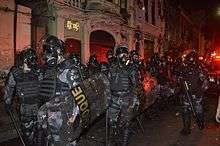
Special Units
- Mounted Police regiment;
- 2 Highway Patrol battalions;
- 5 Environmental Protection units;
- 38 Pacifying Police Units;
- 2 Riot Control battalions;
- Special Police Operations Battalion.
- Police Operations with Dogs battalion (K-9 Unit)
- Railway Police groupment;
- Airmobile groupment;
- Maritime groupment.
Administrative Commands
- Department of Education:
- Dom João VI Military Police Academy (to officer cadets);
- Military Police Formation Center (to non-commissioned officers and soldiers).
- Department of Logistic Support.
- Department of Personnel.
- Department of Finance.
- Department of Intelligence.
- Department of Social Assistance (welfare).
- Social Communication Center
- Communications and Informatic Center.
- Department of Health:
Weapons
| Equipment | Type | Origin | Notes | Photo |
|---|---|---|---|---|
| FN FAL | Rifle | |
Standard | |
| ParaFAL | Rifle | |
Standard | |
| Heckler & Koch PSG1 | Sniper Rifle | |
special operations | |
| M16A2 | Rifle | |
special operations | |
| IMBEL MD2 | Rifle | |
special operations |  |
| M4 | Carbine | |
Standard | 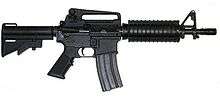 |
| AR-15 | Carbine | |
Standard | |
| Taurus CT-30 | Carbine | |
Standard | |
| Remington Model 1100 | Shotgun | |
riot control | |
| Mossberg 500 | shotgun | |
riot control | |
| MP5 | submachine | |
special operations | 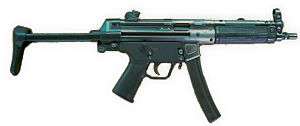 |
| Imbel MT-12 | submachine | |
Standard |  |
| TAURUS FAMAE in .40 | submachine | |
Standard | 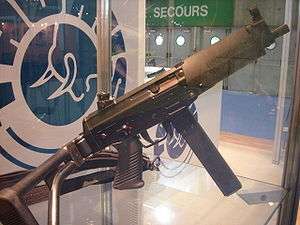 |
| Taurus PT-100 | Pistol | |
Standard | 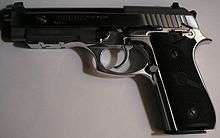 |
| Taurus PT 24/7 | Pistol | |
Standard | 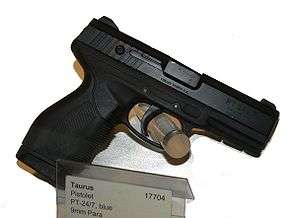 |
| Taurus Model 605 | Revolver | |
Standard |  |
| Taser Pistol | Non-lethal weapon | |
Standard | 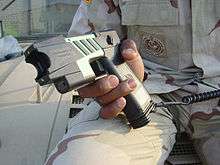 |
| Smoke grenade | Non-lethal weapon | |
riot control and special operations | |
| Riot gun | Non-lethal weapon | |
riot control and special operations |  |
Vehicles inventory
| Model | Manufacturer | Type | Notes | Photo |
|---|---|---|---|---|
| Gol G3 | Volkswagen | Patrol car | Being retired. Patrol rural | |
| Gol G5 | Volkswagen | Patrol car | Vehicle standard | .jpg) |
| Logan | Renault | Patrol car | Vehicle standard |  |
| Voyage G III | Volkswagen | Patrol car | Vehicle standard | 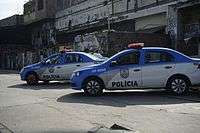 |
| Blazer | Chevrolet | Response car | Vehicle standard | 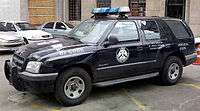 |
| Duster | Renault | Response car | Vehicle standard |  |
| Hilux SW4 | Toyota Motor | Response car / Dog unit Car (K9) | Special police |  |
| Frontier D40 | Nissan | Multi-purpose car | Special police/ Highway patrol |  |
| S-10 Third generation | Chevrolet | Response car | Vehicle standard |  |
| Amarok | Volkswagen | Multi-purpose car | Riot police car |  |
| Master | Renault | Police van | Riot police car |  |
| Daily | Iveco | Police van | Special police |  |
| Ducato | Fiat | Police van | Vehicle standard | |
| XT660 | Yamaha Motor Company | Police motorcycle | Standard |  |
| CB600 | Honda | Police motorcycle | Riot police |  |
| Ford Cargo 815 | Ford Motor Company | Armoured personnel carrier | Vehicle war on drugs | |
| VW Cargo 1722 | Volkswagen | Armoured personnel carrier | Vehicle war on drugs |  |
| Maverick | Paramount Group | Infantry mobility vehicle | Special operations | 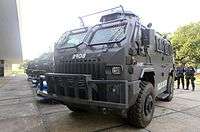 |
| Volkswagen Constellation | Volkswagen | Police truck | Special operations/Water cannon | |
| Backhoe loader | Armoured Heavy equipment | Vehicle auxiliary | ||
Aircraft inventory
| Aircraft | Type | Versions | In service | Photo | Note |
|---|---|---|---|---|---|
| Schweizer 300 | Training | Schweizer 300 CBi | 01 | |
Designated phoenix 6. |
| Eurocopter AS350 | Patrol helicopter | AS-350B3 | 06 (04 active) | 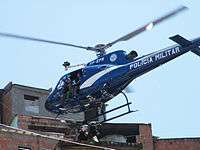 |
Designated phoenix 1,2,3,4,7,8. Phoenix 3 was shot down by narcotraffickers during gunbattle at the Morro dos Macacos in October 2009 while Phoenix 4 suffered a total loss in November 2016. The cause of the fall is still unknown. |
| Bell Huey II | Special operations Armed helicopter |
Huey II | 01 | |
Designated phoenix 5. |
| Eurocopter EC145 | Patrol helicopter SAR |
EC145 | 02 | 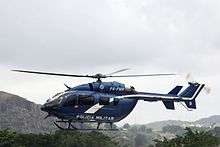 |
Designated phoenix 9 and phoenix 10 |
| Piper PA-34 Seneca | Personal transport | PA-34 | 02 | 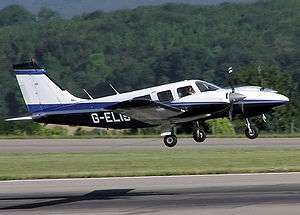 |
|
| Beechcraft Baron | Personal transport | Baron 58 | 01 |  |
|
Uniforms
Since 1975, the PMERJ use dark grey blue in their uniforms or blue with black trousers. Special units have differenr uniforms for each service.
Ranks
The PMERJ has the same hierarchical classification[13] of the Brazilian Army, with another type of insignias.[14]
Ranks and insignia
| Title | Insignia |
|---|---|
| Colonel | |
| Lieutenant Colonel | |
| Major | |
| Captain | |
| First Lieutenant | |
| Second Lieutenant | |
| Aspirant | |
| Cadet or Student Officer (a star for each year) |
|
| Sub-Lieutenant | |
| First Sergeant | |
| Second Sergeant | |
| Third Sergeant | |
| Corporal | |
| Private "A Class" | |
| Private "B Class" or Student Private |
No insignia |
All rank insignia are worn on the epaulettes of the shirt, except for sergeants, corporal and soldiers, which are worn on each sleeve, below the institutional patch (left) and state flag (right).
Gallery
- PAC's – state division
 Police officers – 1950s
Police officers – 1950s- Old PMERJ blazon (until 1975)
 Old PMERJ blazon (between 1975 and 1983)
Old PMERJ blazon (between 1975 and 1983)- Military police operation in Complexo do Alemão (November 2010)
.jpg) Special Police Operations Battalion - Armored vehicle
Special Police Operations Battalion - Armored vehicle.jpg) Military Police in combating crime in the favelas of Rio de Janeiro
Military Police in combating crime in the favelas of Rio de Janeiro- VW Cargo 1722 Military Police armored vehicle
.jpg) Riot Control operation (2013)
Riot Control operation (2013) Police station in Santa Marta favela
Police station in Santa Marta favela Riot control officer
Riot control officer
In popular media
The PMERJ appear in Fast Five, the fifth movie of the Fast and the Furious series, where many of them are corrupt and in the payroll of drug lord Hernan Reyes, being sent to try and retrieve his vault full of his drug money after it was stolen from their station alongside the PRF and Rio civil police. However, thanks to Dominic Toretto and his team, all of their pursuing cruisers are destroyed, their corrupt officers slaughtered, and Reyes himself executed by DSS Agent Luke Hobbs in revenge for murdering his team back in the favelas. Only one officer is shown to be loyal and honorable to her duty as a police officer, Agent Hobbs ally in Rio, Elena Neves, who's husband served in law enforcement before he was killed in the line of duty, inspiring her to join the force, but avoid being corrupted by Reyes as so many of the other officers were.
See also
- Rio de Janeiro State
- Civil Police of Rio de Janeiro State
- Military Police of Brazil
- Batalhão de Operações Policiais Especiais (BOPE)
- Brazilian Federal Police
- National Force of Public Safety
- Federal Highway Police
- Brazilian Civil Police
- Brazilian Armed Forces
- Military Police
- Gendarmerie
References
- ↑ Article 144 of Constitution of Brazil.
- ↑ Article 42 of Constitution of Brazil.
- ↑ Decree of December 10, 1801.
- ↑ Decree of May 13, 1809.
- ↑ Law of July 17, 1831.
- ↑ Law of October 10, 1931.
- ↑ Constitutional Reform of 1834, Article 15, § 11.
- 1 2 "Osso duro de roer: veja imagens dos 35 anos do Bope, a elite da PM do Rio - Fotos - UOL Notícias". UOL Notícias (in Portuguese). Retrieved 2016-02-17.
- ↑
- ↑
- ↑ Reportagem do Fantástico em 27 de setembro de 2009 sobre os snipers do BOPE.
- ↑ http://www.revistaforum.com.br/blog/2014/02/upp-os-cinco-motivos-que-levaram-a-falencia-o-maior-projeto-do-governo-cabral/
- ↑ Ordinance of the Ministry of the Army 340, October 4, 1971.
- ↑ Decree 3,568, March 02, 2001.
External links
| Wikimedia Commons has media related to Police of Rio de Janeiro. |
- Official website of Military Police of Rio de Janeiro State (in Portuguese)
